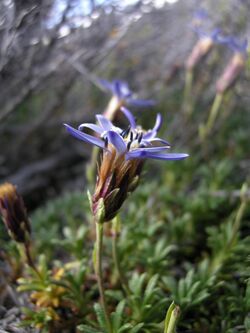Biology:Perezia (plant)
From HandWiki
Short description: Genus of flowering plants
| Perezia | |
|---|---|

| |
| Perezia recurvata | |
| Scientific classification | |
| Kingdom: | Plantae |
| Clade: | Tracheophytes |
| Clade: | Angiosperms |
| Clade: | Eudicots |
| Clade: | Asterids |
| Order: | Asterales |
| Family: | Asteraceae |
| Subfamily: | Mutisioideae |
| Tribe: | Nassauvieae |
| Genus: | Perezia Lag. |
| Type species | |
| Perezia magellanica (L.f.) Lag.
| |
| Species | |
|
About 30-35 | |
Perezia is a genus of flowering plants in the family Asteraceae. It is distributed in South America, especially in the central and southern Andes.[1]
Though some species occur at sea level, most Perezia grow in high-elevation mountain habitat. Species are found in most high Andean ecosystems, except for the páramo.[1]
Some species are used in traditional medicine in South America. P. multiflora is used to treat postpartum hemorrhage, P. pinnatifida is used as a sedative, and P. purpurata is used as an anti-inflammatory.[2]
There are about 30 to 35 species in the genus.[1]
Species include:[3]
- Perezia atacamensis
- Perezia bellidifolia
- Perezia calophylla
- Perezia carduncelloides
- Perezia carthamoides
- Perezia catharinensis
- Perezia ciliaris
- Perezia ciliosa
- Perezia delicata
- Perezia dicephala
- Perezia eryngioides
- Perezia fonkii
- Perezia fosbergii
- Perezia kingii
- Perezia lactucoides
- Perezia linearis
- Perezia lyrata
- Perezia macrocephala
- Perezia magellanica
- Perezia mandoni
- Perezia megalantha
- Perezia multiflora – escorzonera, chanqoroma[2]
- Perezia nutans
- Perezia pedicularidifolia
- Perezia pilifera
- Perezia pinnatifida – valeriana[2]
- Perezia poeppigii
- Perezia prenanthoides
- Perezia pungens
- Perezia purpurata – marancel[2]
- Perezia pygmaea
- Perezia recurvata
- Perezia spathulata
- Perezia squarrosa
- Perezia sublyrata
- Perezia virens
- Perezia volcanensis
References
- ↑ 1.0 1.1 1.2 Simpson, Beryl B.; Arroyo, Mary T. K.; Sipe, Sandra; Dias De Moraes, Marta; McDill, Joshua (2009). "Phylogeny and evolution of Perezia (Asteraceae: Mutisieae: Nassauviinae)". Journal of Systematics and Evolution 47 (5): 431–443. doi:10.1111/j.1759-6831.2009.00039.x.
- ↑ 2.0 2.1 2.2 2.3 Gallardo, Amalia B.; Cueto, Mercedes; Díaz-Marrero, Ana R.; Cuadra, Pedro; Fajardo, Victor; Darias, José (2011). "The recurvatianes: A suite of oxygenated guaiane sesquiterpenes from Perezia recurvata". Phytochemistry 72 (2–3): 284–289. doi:10.1016/j.phytochem.2010.11.021. PMID 21195438. http://www2.cmu.edu.tw/~cmcphati/100-seminar/1001201-seminar/1001201-5160-1.pdf.
- ↑ Perezia. The Plant List.
External links
- Apodaca, M.J., J.V. Crisci, and L. Katinas. (2015). Andean Origin and Diversification of the Genus Perezia, an Ancient Lineage of Asteraceae. Washington, D.C.: Smithsonian Institution Scholarly Press.
- Perezia. Preliminary Checklist of the Compositae of Bolivia. Royal Botanic Gardens, Kew.
Further reading
- (in Spanish) Katinas, L. (2012). Revisión del género Perezia (Compositae). Boletín de la Sociedad Argentina de Botánica 47(1-2), 159–261.
Wikidata ☰ Q5234567 entry
 |

